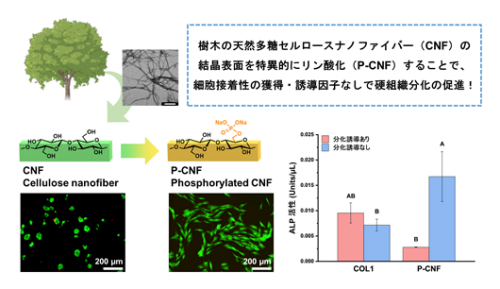Professor KITAOKA Takuya and his research team successfully cultured human dental pulp stem cells by controlling wood nanofiber structures.
Regenerative dental medicine using wood-derived cellulose nanofibers
Points
- While regenerative dental medicine using dental pulp stem cells*1 is gaining attention, the cell culture scaffolds for dentin regeneration rely on animal-derived components or autologous dental materials.
- By introducing phosphate groups to the surface of cellulose nanofibers (CNF)*2 derived from trees, researchers have successfully developed a cell culture scaffolds that mimic the morphology and biological properties of the human extracellular matrix (ECM)*3
- Due to the phosphate group-dependent stem cell proliferation behavior and the ability to induce hard tissue differentiation without external differentiation factors, this approach is expected to be an effective new medical modality for regenerative dental medicine.
Abstract
In the era of 100-year lifespans, regenerative dental treatment is gaining attention as a crucial method for extending healthy life expectancy. This innovative approach uses dental pulp stem cells, which can be minimally invasively obtained from primary and wisdom teeth, as a fundamental treatment alternative to traditional cavity filling methods. However, there are many challenges, such as using non-human animal collagen or autologous dental materials as a scaffold for dental regeneration.
By specifically introducing phosphate groups to the surface of wood-derived CNF, researchers have successfully cultured human dental pulp stem cells and achieved hard tissue differentiation without adding external differentiation factors.
A collaborative research group consisting of IWASAKI Akihiro (Master's course, second year), Qimei Liu (Master's degree completed in 2023) from the Graduate School of Bioresource & Bioenvironmental Sciences of Kyushu University, Assistant Professor HATAKEYAMA Mayumi, Professor KITAOKA Takuya from Kyushu University's Faculty of Agriculture, Assistant Professor ORIMOTO Ai from Kyushu Dental University, and Professor FUKUDA Tomokazu from Iwate University have focused on the common nanostructures shared by wood and humans, namely "nanofiber shapes" and "regular polysaccharide interface structures." They discovered that by introducing phosphate groups into wood-derived CNF, which inherently lacks cell adhesion capabilities, while maintaining its crystalline structure, they could induce excellent cell adhesion, culture properties, and hard tissue differentiation as a biomineralization scaffold.
This discovery not only expands the potential for dental treatments using human dental pulp stem cells, but also contributes to the development of biomaterials from natural polysaccharide nanofibers as a new medial modality for stem cell culture scaffolds.
This research was published in Elsevier's academic journal "Carbohydrate Polymers" on April 12, 2025.
Comment from the researcher

This study discovered that CNF derived from familiar trees can promote the adhesion and differentiation of stem cells in dental tissue. Through this research, I learned not only about the new potential of natural polysaccharides but also about the challenges and joys of research. I hope to continue contributing to the fields of materials and cell research and achieve further advancements. (IWASAKI Akihiro , Master's course, second year)
Glossary
*1 Dental Pulp Stem Cells
Stem cells found in dental pulp, commonly referred to as "dental nerves," are relatively easy to harvest, exhibit strong proliferative capacity, and have a low risk of tumor formation. These characteristics make them a promising cell source for regenerative medicine.
*2 Cellulose Nanofibers (CNF)
Cellulose, the main component of plants such as trees and grasses, is refined into a natural nanomaterial at the nanoscale (one nanometer is one billionth of a meter).
*3 Extracellular Matrix (ECM)
The extracellular matrix (ECM) is a complex composed of proteins and polysaccharides that fills the spaces between animal cells, playing a crucial role in cell proliferation, differentiation, and phenotype regulation. Similarly, plant cell walls function as the "extracellular matrix of plants," performing various physiological functions.
Paper Information
Journal: Carbohydrate Polymers
Title: Proliferation and differentiation of human dental pulp stem cells on phosphorylated cellulose nanofiber scaffolds
Authors: Akihiro Iwasaki, Mayumi Hatakeyama, Qimei Liu, Ai Orimoto, Tomokazu Fukuda, Takuya Kitaoka
DOI:10.1016/j.carbpol.2025.123593
For Research-related inquiries












 Contact
Contact
 Access Map
Access Map

